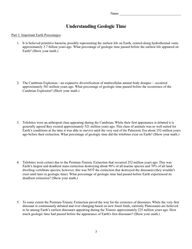
Return to flip book view
3 Name: _______________________________________ Understanding Geologic Time Part 1: Important Earth Percentages 1. It is believed primitive bacteria, possibly representing the earliest life on Earth, existed along hydrothermal vents approximately 3.7 billion years ago. What percentage of geologic time passed before the earliest life appeared on Earth? (Show your math.) 2. The Cambrian Explosion—an expansive diversification of multicellular animal body designs— occurred approximately 541 million years ago. What percentage of geologic time passed before the occurrence of the Cambrian Explosion? (Show your math.) 3. Trilobites were an arthropod class appearing during the Cambrian. While their first appearance is debated it is generally agreed they existed approximately 521 million years ago. This class of animals was so well suited for Earth’s conditions at the time it was able to survive until the very end of the Paleozoic Era about 252 million years ago before their extinction. What percentage of geologic time did the trilobites exist on Earth? (Show your math.) 4. Trilobites went extinct due to the Permian-Triassic Extinction that occurred 252 million years ago. This was Earth’s largest and deadliest mass extinction destroying about 96% of all marine species and 70% of all land-dwelling vertebrate species; however, this was NOT the extinction that destroyed the dinosaurs (they wouldn’t exist until later in geologic time). What percentage of geologic time had passed before Earth experienced its deadliest extinction? (Show your math.) 5. To some extent the Permian-Triassic Extinction paved the way for the existence of dinosaurs. While the very first dinosaur is continuously debated and ever changing based on new fossil finds, currently Plateosaurs are believed to be among Earth’s earliest dinosaurs appearing during the Triassic approximately 225 million years ago. How much geologic time had passed before the appearance of Earth's first dinosaurs? (Show your math.)
4 6. The Cretaceous-Paleogene Extinction [also known as the Cretaceous-Tertiary Extinction] occurred approximately 66 million years ago. It was this mass extinction event that drove the dinosaurs into extinction. How much geologic time had passed before the extinction of the dinosaurs? (Show your math.) 7. During the Permian period, approximately 275 million years ago, an interesting group of stem mammals known as therapsids appeared demonstrating the first semblance of mammal-like traits. How much geologic time had passed before the first appearance of the therapsids? (Show your math.) 8. Looking at the reign of the dinosaurs, they lasted almost the entire Mesozoic Era from start to finish. They lived from roughly 225 to 66 million years. What percentage of geologic time did the dinosaurs exist on Earth? (Show your math.) 9. According to fossil evidence, an early archaic human known as Homo erectus appeared 2 million years ago during the Pleistocene Epoch. How much geologic time had passed before the first appearance of Homo erectus? (Show your math.) 10. According to archaeological evidence the earliest modern humans (Homo sapiens) [at time of writing] appeared approximately 300,000 years ago during the Pleistocene Epoch. What percentage of geologic time had passed before the first appearance of modern humans? [Your answer will be small and should extend at least 3 places past the decimal point.] (Show your math.) Part 2: Significant Events in Geologic Time
5 11. Plateosaurs, believed to be the very first dinosaurs, appeared as early as 214 million years ago during the __________________ Period. 12. Around 55.5 million years ago the warmest Cenozoic temperatures were experienced during the __________________ Epoch. 13. An explosive amount of multicellular life diversification occurred 541 million years ago. This was during the __________________ Period. 14. Earth’s earliest amphibians appeared between 359 and 419 million years ago during the __________________ Period. 15. This time segment can essentially be thought of as the Age of Trilobites as they persisted from nearly the beginning to the very end of the __________________ Era. 16. The __________________ Period and the __________________ Period, or the __________________ Period in North America, create almost the entire Cenozoic Era. 17. During the __________________ Epoch between 5 and 23 million years ago grasses were widespread and became a dominant plant that resulting in many mammals evolving to become grazers. 18. This time segment can be thought of as the Age of Mammals as they dominated and continue to dominate the __________________ Era. 19. Earth’s deadliest mass extinction occurred approximately 252 million years ago during the __________________ Period. 20. First appearing between 250,000 and 350,000 years ago, neanderthals (Homo neanderthalis) and modern humans (Homo sapiens) made their first appearances and even coexisted during the __________________ Epoch. 21. Between 444 and 486 million years ago Earth’s oceans were dominated by molluscs and arthropods during the __________________ Period. 22. The __________________ Era is often referred to as the Age of Dinosaurs. 23. The arthropod subclass Euthycarcinoid was likely the first ever animal to walk on dry land approximately 420 million years ago during the __________________ Period. 24. The supercontinent Pangaea formed approximately 335 million years ago during the __________________ Period, which is also known as the __________________ Period in North America. 25. Starting approximately 11,650 years ago after the last glacial period, the __________________ Epoch can essentially be considered as the Age of Humans. 26. Earth’s first birds and mammals appeared between 146 and 208 million years ago during the __________________ Period. 27. Around 66 million years ago an asteroid crashed into Earth during the __________________ Period impacting the ecosystem and causing many animals including the Tyrannosaurus rex to go extinct. 28. This represents the oldest epoch in the Cenozoic Era and featured much large mammal development. This is the __________________ Epoch.
6 29. An enormous time segment that extends from 541 million years ago to the very second you read this sentence is the __________________ Eon. 30. The geologic time segment you live in right now is the __________________ Period.